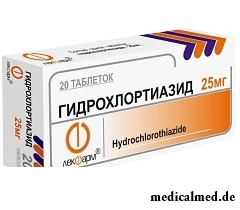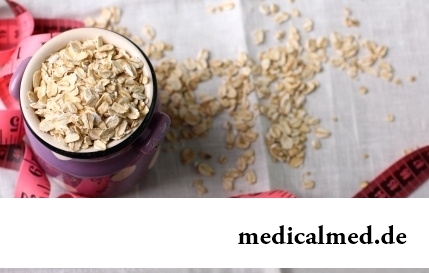





Hydrochlorthiazidum
Application instruction:
 Hydrochlorthiazidum – drug with diuretic action.
Hydrochlorthiazidum – drug with diuretic action.
Form of release and structure
Hydrochlorthiazidum is released in the form of tablets (on 10 pieces in blister strip packagings, on 2 packagings in a cardboard pack).
Active agent is a part of 1 tablet: a hydrochlorothiazide – 25 or 100 mg.
Indications to use
- Arterial hypertension (as monotherapy or along with other hypotensive medicines);
- Control of a polyuria (most often at a nephrogenic not diabetes mellitus);
- Edematous syndrome of various genesis (nephrotic syndrome, chronic heart failure, acute glomerulonephritis, premenstrual syndrome, portal hypertensia, chronic renal failure, treatment by corticosteroids).
Also Hydrochlorthiazidum is shown for prevention of formation of stones in an urinogenital path at predisposed patients (for reduction of a hypercalcuria).
Contraindications
- Anury;
- Unmanageable diabetes mellitus;
- Hepatic or heavy renal (the clearance of creatinine is less than 30 ml in a minute) insufficiency;
- Gout;
- Addison's disease;
- Hypercalcemia, hypopotassemia, hyponatremia;
- First trimester of pregnancy and period of a lactation;
- Age up to 3 years;
- Hypersensitivity to drug components, and also to other sulfonamides.
It is necessary to be careful at use of Hydrochlorthiazidum by women in the II-III trimesters of pregnancy.
Route of administration and dosage
Hydrochlorthiazidum is accepted inside.
For a lowering of arterial pressure drug appoint 25-50 mg in a daily dose. As a rule, the insignificant natriuresis and a diuresis are noted in the first day of therapy. Drug is used for a long time along with other hypotensive medicines: inhibitors of an angiotensin-converting enzyme (APF), vazodilatator, beta adrenoblockers, sympatholytics. At increase in a dose from 25 to 100 mg proportional increase in a natriuresis, a diuresis and a lowering of arterial pressure is usually observed. At reception of Hydrochlorthiazidum in a single dose more than 100 mg further lowering of arterial pressure and increase of a diuresis are insignificant, at the same time disproportionate increase in loss of electrolytes, especially Mg2 + and K+ is observed. Increase in a dose up to 200 mg is also more inexpedient as strengthening of a diuresis does not happen.
At an edematous syndrome Hydrochlorthiazidum is appointed in the doses which are defined by a state and reaction of the patient to therapy. The daily dose can vary from 25 to 100 mg. Drug is accepted once in the morning or in the first half of day in 2 receptions. Patients of advanced age usually accept 1-2 times a day 12,5 mg.
To children from 2 months to 14 years Hydrochlorthiazidum is appointed at the rate of 1 mg/kg a day.
The maximum daily doses are defined by age:
- Children up to 6 months – 3,5 mg/kg;
- Children up to 2 years – 12,5-37,5 mg;
- Children of 3-12 years – 100 mg.
The daily dose is accepted in 2-3 receptions.
After 3-5 days of therapy it is recommended to take a break for 3-5 days. As the maintenance therapy in the specified dose Hydrochlorthiazidum is appointed by 2 times a week. At use of a discontinuous course of treatment with administration of drug in 1-3 days or within 2-3 days with the subsequent break side effects develop less often and reduction of efficiency is expressed to a lesser extent.
For decrease in intraocular pressure Hydrochlorthiazidum is usually appointed 1 time in 1-6 days on 25 mg. As a rule, the effect develops in 1-2 days.
At not diabetes mellitus of a tablet it is necessary to accept 1-2 times a day 25 mg with gradual increase in a dose up to 100 mg (before achievement of medical effect – reduction of a polyuria and thirst). Further decrease in a dose is possible.
Side effects
- Bodies of digestive tract: pancreatitis or cholecystitis, lock, cholestatic jaundice, sialadenitis, diarrhea, anorexia;
- Nervous system and sense bodys: indistinct sight (temporary), dizziness, paresthesias, headache;
- Cardiovascular system and blood (hemostasis, hemopoiesis): vasculitis, orthostatic hypotension, arrhythmias; very seldom – an agranulocytosis, a leukopenia, hemolitic anemia, thrombocytopenia, aplastic anemia;
- Disturbance of electrolytic balance: hyponatremia (convulsions, confusion of consciousness, delay of process of thinking, lethargy, excitability, fatigue, muscular spasms); the hypomagnesiemia, a hypopotassemia, a hypercalcemia (thirst, dryness in a mouth, changes in mentality or mood, an irregular heart rhythm, spasms and muscle pain, vomiting, nausea, unusual weakness or fatigue), besides a gipokhloremichesky alkalosis can cause a hepatic coma or hepatic encephalopathy;
- Metabolic phenomena: a glucosuria, a hyperglycemia, a hyperuricemia with development of an attack of gout. Therapy of a tiazidama can lower tolerance to glucose, and the diabetes mellitus latentno proceeding can demonstrate. At use of high doses of Hydrochlorthiazidum increase in level of lipids in blood serum is possible;
- Hypersensitivity reactions: a purpura, a small tortoiseshell, Stephens-Johnson's syndrome, a necrotic vasculitis, photosensitivity, a respiratory distress syndrome (including not cardiogenic hypostasis of a lung and a pneumonitis), anaphylactic reactions up to shock;
- Others: disturbance of renal function, decrease in a potentiality, intersticial nephrite.
Special instructions
At prolonged course treatment it is necessary to control carefully clinical signs of disturbance of water and electrolytic balance, first of all, at patients of group of the increased risk. Patients with abnormal liver functions and diseases of cardiovascular system treat them, and also patients at whom severe vomiting developed or appeared such signs of disturbance of water and electrolytic balance as thirst, dryness in a mouth, weakness, drowsiness, a lethargy, concern, spasms or muscular pains, tachycardia, muscular weakness, an oliguria, hypotension, complaints from digestive tract.
Development of a hypopotassemia, especially at the strengthened potassium loss (long treatment, a profound diuresis) or at simultaneous treatment by glycosides of a foxglove or corticosteroid medicines, it is possible to avoid, accepting kaliysoderzhashchy drugs or food rich with potassium (fruit, vegetables). Tiazida increase removal with magnesium urine, it can lead to development of a hypomagnesiemia.
At the lowered function of kidneys it is necessary to control clearance of creatinine. With an impaired renal function Hydrochlorthiazidum can cause an azotemia in patients. Development of cumulative effects is also possible. At an obvious renal failure in case of an oliguria it is recommended to consider the possibility of cancellation of therapy.
At a heavy cerebral and coronary sclerosis purpose of Hydrochlorthiazidum demands extra care.
Patients with dysfunctions or the progressing liver diseases should apply Hydrochlorthiazidum with care as little changes of level of ammonium in serum, and also water and electrolytic balance can lead to development of a hepatic coma.
Use of Hydrochlorthiazidum can break portability of glucose. During a long course of therapy at the latent or demonstrating diabetes mellitus it is necessary to control metabolism of carbohydrates systematically.
Barbiturates, alcohol and narcotic analgetics can strengthen orthostatic hypotensive effect of Hydrochlorthiazidum.
At long treatment the pathological change of epithelial bodies which is followed by a hypophosphatemia and a hypercalcemia was in rare instances observed.
The patients having a lactose intolerance can have gastrointestinal complaints that it is connected with existence in structure of tablets of lactose.
At the beginning of therapy (duration of this period is defined individually) to drive the car and to perform the works requiring special attention it is forbidden.
Medicinal interaction
The medicines (Clofibratum, indirect anticoagulants, non-steroidal anti-inflammatory drugs) which are intensively contacting proteins strengthen diuretic effect of Hydrochlorthiazidum.
The hypotensive effect of drug is strengthened by vazodilatator, tricyclic antidepressants, beta adrenoblockers, fenotiazina, barbiturates, ethanol.
Hydrochlorthiazidum strengthens a neurotoxicity of salicylates; reduces removal of quinidine and effect of oral contraceptives; weakens effect of peroral hypoglycemic drugs, Epinephrinum, Norepinephrinum and antigouty medicines; strengthens side effects of cardiac glycosides, neurotoxic and cardiotoxic effect of the drugs Li+, action of peripheral muscle relaxants.
At a concomitant use of Hydrochlorthiazidum with metildopy hemolysis development is possible.
Terms and storage conditions
To store in protected from light, the place, dry, unavailable to children, at a temperature up to 25 °C.
Period of validity – 2 years.
Name of drug
Price
Drugstore
In our intestines are born, millions of bacteria live and die. They can be seen only at strong increase, but if they gathered, then would be located in a usual coffee cup.

(Xerostomia) many people consider feeling of a xerostomia small and easily removable inconvenience. This delusion...
Section: Articles about health
The problem of diagnosis was and remains to one of the most important in medicine. From that, the reason of an indisposition of the patient will be how precisely defined, eventually success of treatment depends. In spite of the fact that the majority of the diagnostic methods applied in about...
Section: Articles about health
All know that self-treatment is dangerous. However absolutely it is almost impossible to do without it. Rate of modern life does not allow to handle each small trouble to the doctor and information on ways of independent delivery of health care is quite available. Means, all of us have only one: to learn to give this help competently and in those limits in which it is possible for the person who does not have vocational education....
Section: Articles about health
Nightmares belong to the most unpleasant frustration. Statistically, they happen at 4% of adults, and almost at 70% of children and...
Section: Articles about health
High temperature - a frequent symptom of such widespread diseases as a SARS, quinsy, pneumonia, etc. To reduce heat, having facilitated a condition of the patient, doctors recommend to accept antipyretics, however their use is not always possible. Too h...
Section: Articles about health
Contrary to popular belief, the multiple sclerosis (MS) is not connected neither with sclerous changes of walls of vessels, nor with age forgetfulness and problems with concentration of attention. This disease has the autoimmune nature. Pathological process is expressed in degradation of nervous tissue and destruction of its enveloping layer - a myelin. Multiple damages of the central nervous system which are shown by decrease in sight, bystry fatigue, on become result of development of an illness...
Section: Articles about health
The list of stereotypes of which, apparently, all know strongly includes following: British surely eat for breakfast овсянк...
Section: Articles about health
Feeding by a breast - the integral part of ideal motherhood allowing to come into contact with the kid and to create to it healthy immunity since early years. Nevertheless, this important process in life of mother and child can be saddened laktostazy − by a delay of milts...
Section: Articles about health
About influence of fasting days on an organism it is told much – both about advantages, and about shortcomings. It is considered that fasting day in the form of a short-term monodiet is useful, promoting effective removal of slags from an organism whereas irregular, excessively long, spontaneous fasting days lead only to deterioration in health. How to derive benefit from the sparing diet and not to do much harm to itself? Let's consider the main advantages and shortcomings of fasting days and their influence on an org...
Section: Articles about health
All parents are ready to what the baby often and pisat much. Since then, as the absorbing diapers strongly became current...
Section: Articles about health
The immunity role in growth of the child is invaluable. The proteins-immunoglobulins produced by immune system preserve the child against the diseases capable − owing to an organism weak still − to serve as a stressful factor, to become the reason of many complications and delays in unless...
Section: Articles about health
In consciousness of our many compatriots idea that folk remedies if are no more effective, than medicinal "chemistry" strongly took roots, then are precisely less harmful. Unfortunately, it is not always fair: some methods of treatment consecrated with "century national experience" can work so on the patient that it will need urgent intervention of physicians....
Section: Articles about health
Each person knows that fervescence is an illness sign. However about existence of diseases can to suite...
Section: Articles about health
Summer in the heat. Many are going to spend vacation abroad. Travelers the tender seas, rest on beaches wait, for sightseeing, campaigns on natural and cultural reserves. But, unfortunately, on vacation also problems about health can wait for us...
Section: Articles about health
On the head of the person about one million hair follicles, or as they are called still, hair bulbs are located. At the time of the birth most of them is in the "sleeping" state, but within several weeks follicles become more active, and from them hair begin to grow. Intensity of this process is individual, and during life it can change. Genetic predisposition, a physical and emotional state, aggressive influence affects the growth rate of hair out of...
Section: Articles about health
The state of health of the person in many respects depends on food. The organism will well function if during food it are...
Section: Articles about health
Statistically cystitis 25-30% of women up to 40 years have. With age this indicator raises, besides many do not get to statistics because do not see a doctor. The most sad that after the regular visits to doctors, long reception of antibiotics...
Section: Articles about health
For anybody not a secret that the modern person eats not as his ancestors. For the last 100 years in broad access there were absolutely new products which are result of use of the latest technologies in food production. Significantly ways of storage and transportation of food ingredients changed, and people of the whole world had an opportunity to regularly use those products about which their grandfathers and grandmothers did not even know....
Section: Articles about health
Health and attractiveness - eternal values, pursuing which people often use the most unusual ingredients and technicians...
Section: Articles about health
Zone hypostases under eyes - very widespread problem giving to people is a lot of inconvenience. Hypodermic fabric in these parts has very loose structure and almost does not contain collagenic fibers. Besides, the skin covering подглазья constantly is exposed...
Section: Articles about health
The business lady, the become mother, it is necessary to solve an array of problems. But of them is main: how to combine the beloved child and work? What traps trap the working mother and how she needs to behave?...
Section: Slideshow
Epilepsy is one of widespread neurologic diseases. To parents, whose children suffer from this illness, it is necessary...
Section: Articles about health
An eye of the person daily experiences considerable strain. The problem of preservation of sight is for many years directly connected with a question of supply of tissues of eye enough oxygen and nutrients. This task is carried out by small vessels – capillaries. For holes...
Section: Articles about health
There comes the season of issues. Many Russians already dream of outdoor recreation, trips, beautiful seaside beaches. At this time there is no wish to think of problems with health and other unpleasant things, however there are subjects which require attention. In the summer repeatedly the risk increases to ache with some very dangerous illnesses, we also will talk about them today....
Section: Articles about health
It is possible to find the extensive range of fruit and vegetables in modern shops. Russians already got used that on counters in any...
Section: Articles about health
It would seem, about it there can be no disagreements: water is necessary for a human body for normal life activity, and about how and when it should be drunk, all know. It turned out that the situation is not absolutely so: for many years occur ве...
Section: Articles about health
Turnip, radish, horse-radish – once these and other products enjoyed wide popularity at our ancestors, being not only the food sating an organism but also the medicines curing of many diseases. Unfortunately, the use of some of them got out of fashion long ago, and once favourite plants and vegetables almost ceased to make a contribution to human health. Inclusion of such products in a modern diet − an effective measure of prevention and treatment of diseases which seldom suffered...
Section: Articles about health

